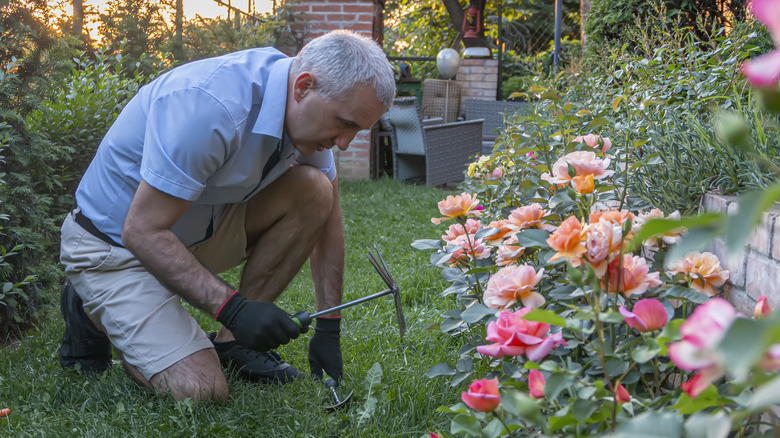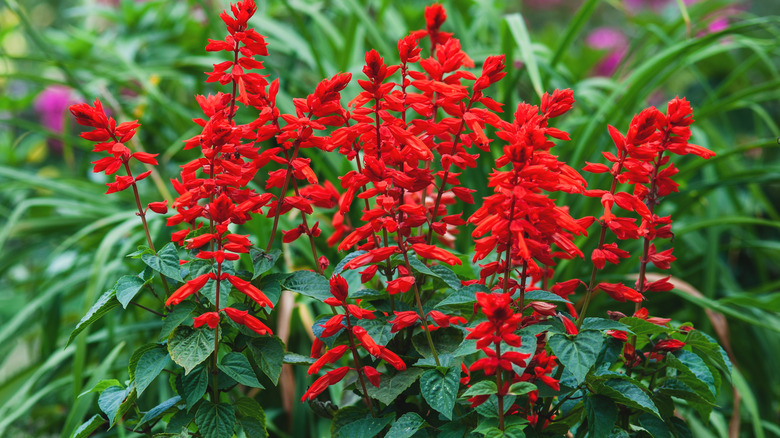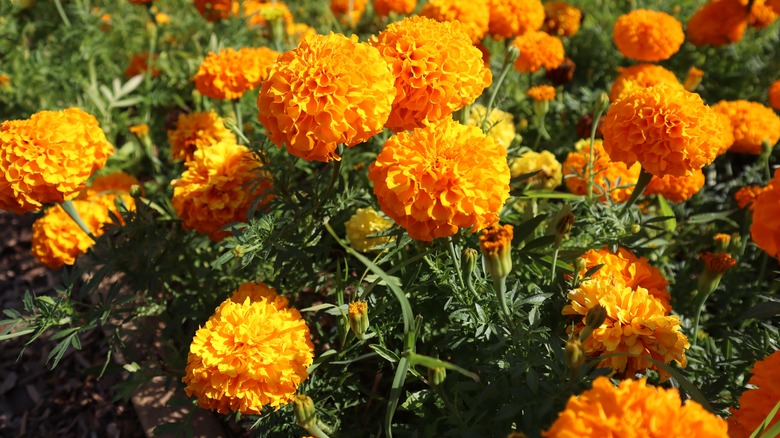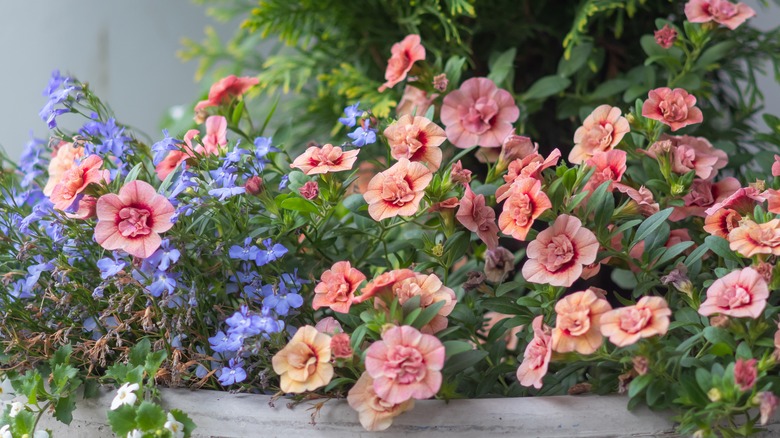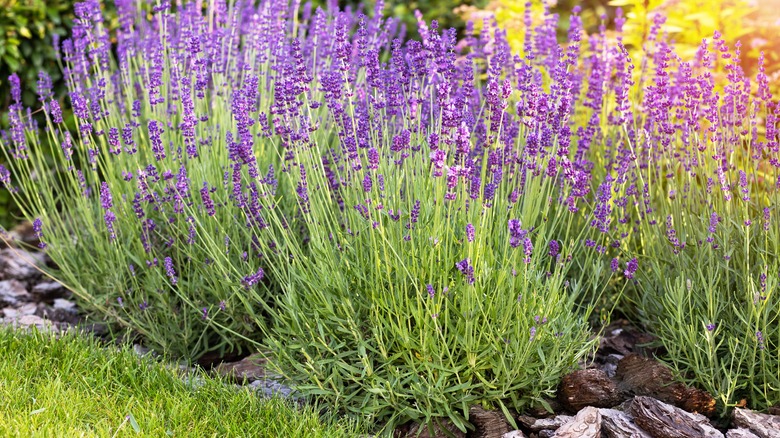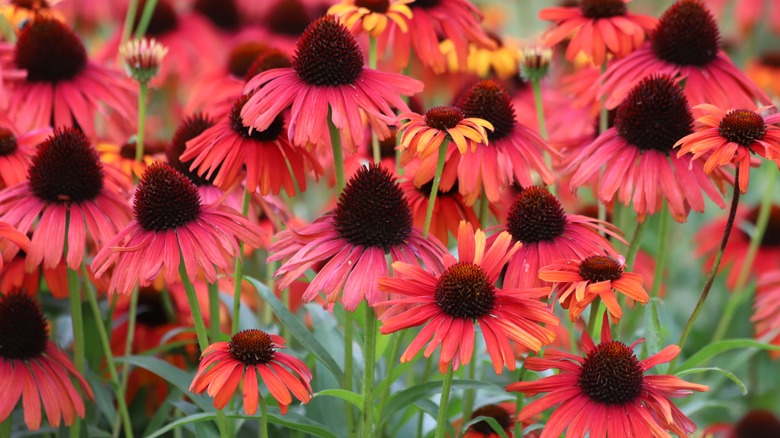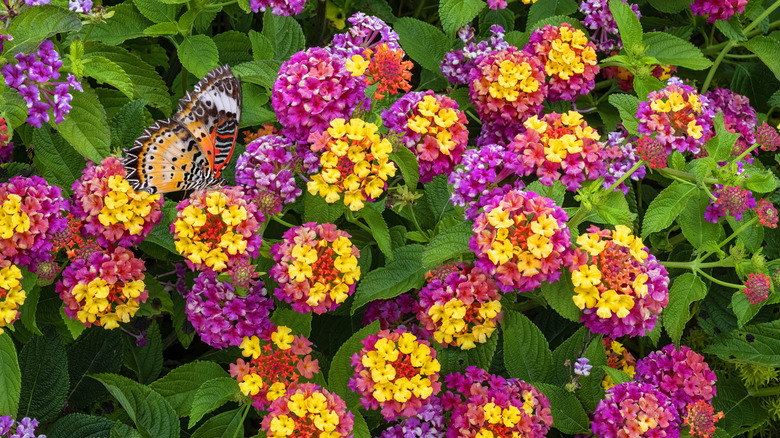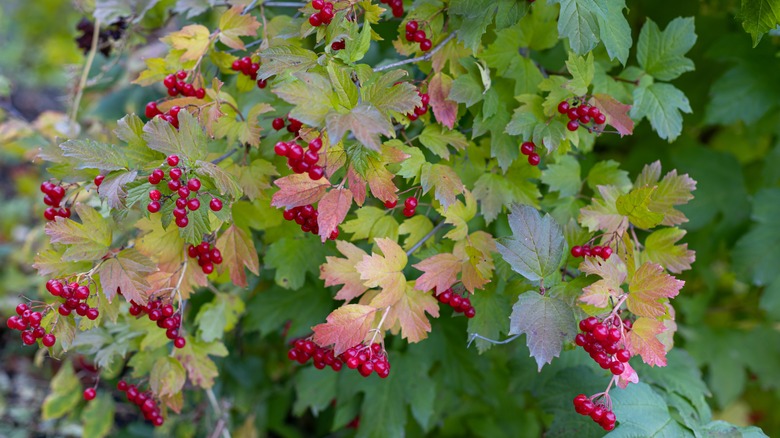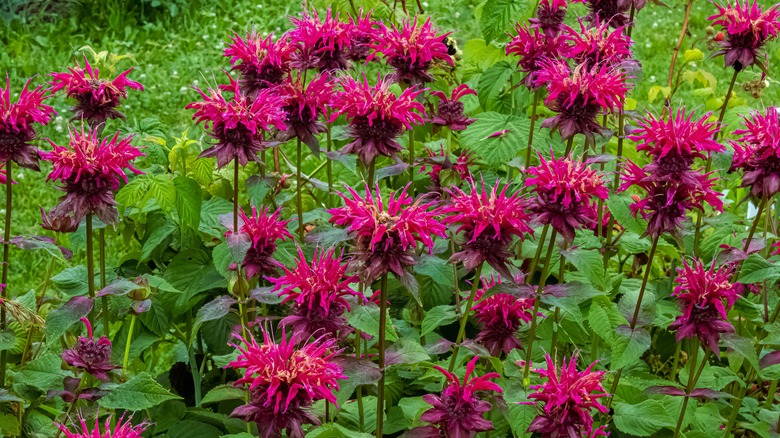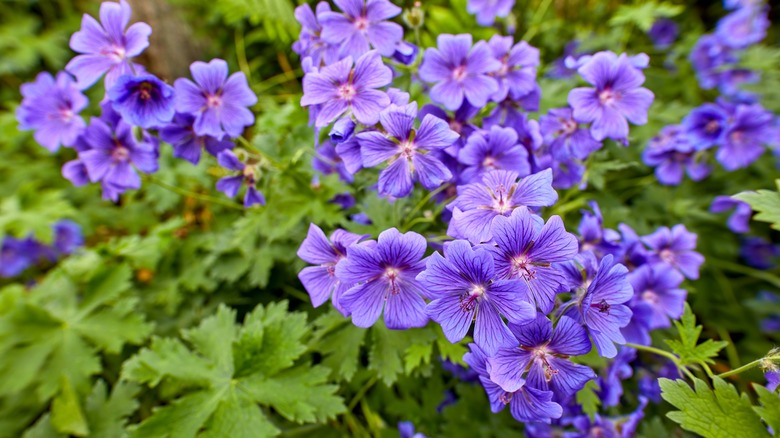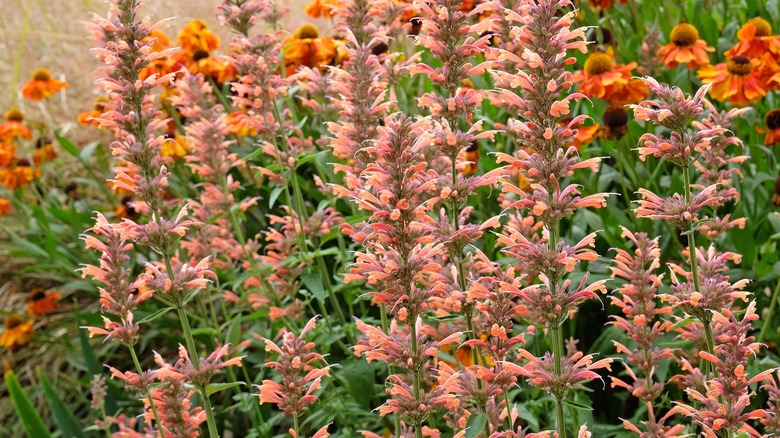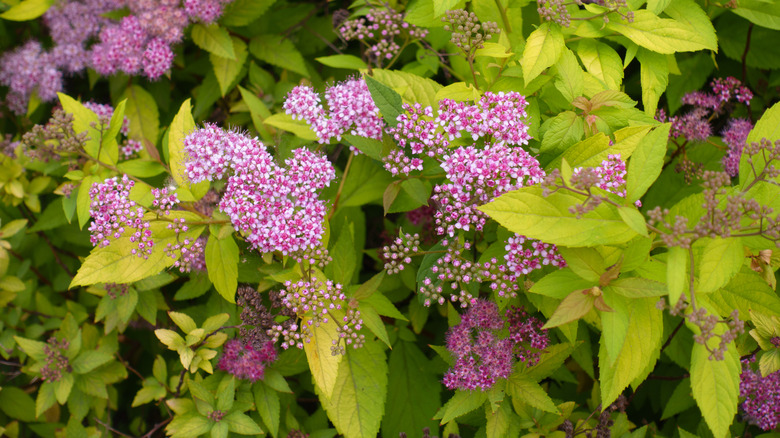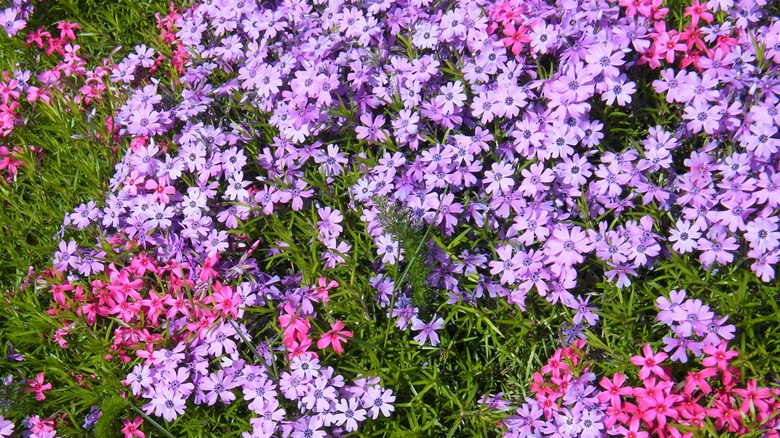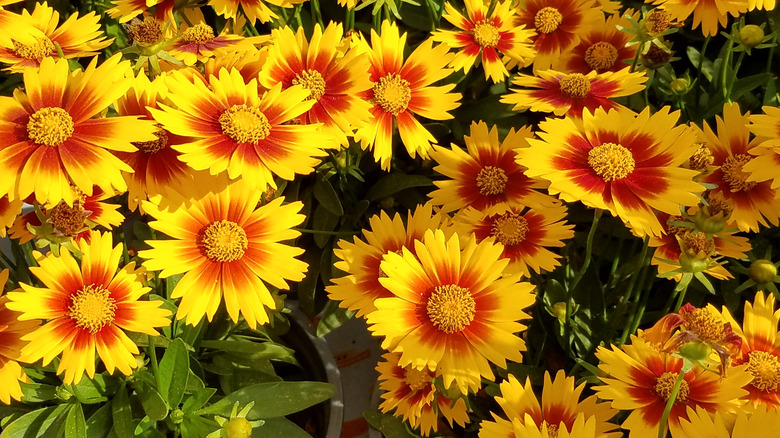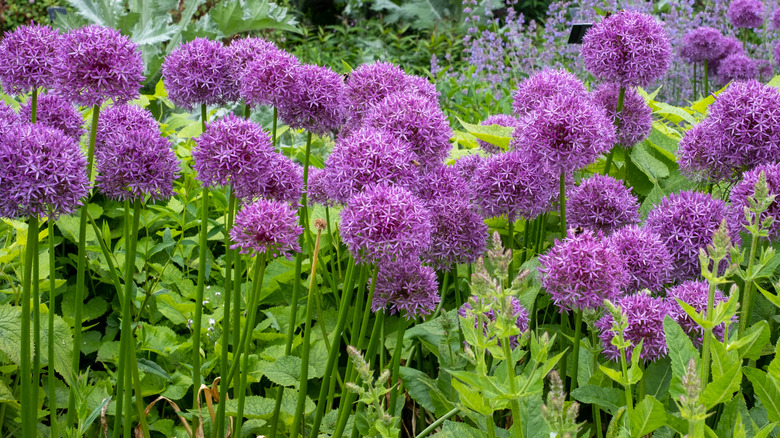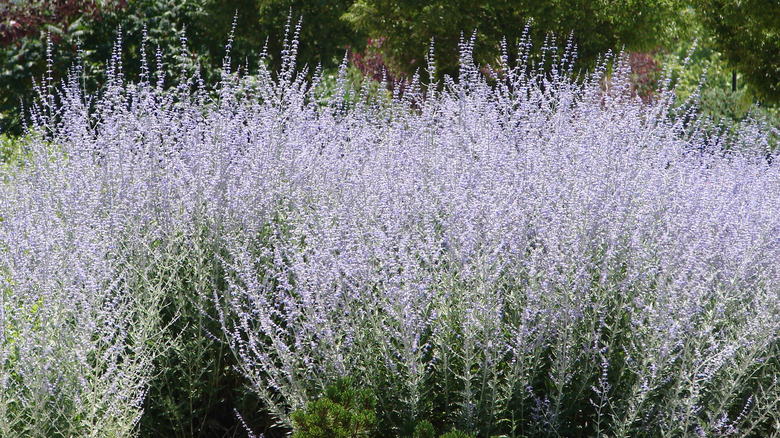Grow These 15 Companion Plants With Your Roses For A Showstopping Garden Of Color
Roses are the pride and joy of many backyard gardeners, but maintaining roses can be tricky, especially if you decide to diversify your garden bed with some different plant varieties. Good companion plants for roses love full sun, are relatively pest-resistant, and stay within their personal space to allow sunlight and airflow to the rose bush's base. In general, you'll want to avoid fast-spreading plants or plants with widespread root systems that could choke out your roses and grow your companion plants at least 12 inches away from your rose bush, just to be safe. Luckily, there are many suitable options that fit these necessary criteria, and they don't have to be boring. In fact, plenty of eye-catching and vibrant plants will play well with roses!
Roses usually take center stage in a garden, but they need an ensemble to really help them shine. Using companion plants can be one of the best clever tricks that will help your rose garden thrive, especially if you choose the right ones to provide pest protection and other benefits in addition to aesthetic beauty. Here are 15 colorful companion plants, from yellow marigolds to purple alliums, that will look gorgeous beside your roses while keeping them strong and healthy.
1. Salvia
Salvia is a broad genus with several plants featuring radiant, tubular blooms in shades of white, red, purple, or coral. These perennials will generally do well in USDA zones 7 to 11, and are surprisingly low-maintenance, thriving in full sun and tolerating droughts with ease. These flowers are extremely attractive to pollinators like bees, moths, butterflies, and hummingbirds, so they're perfect for drawing a buzz of fun activity into your rose garden. Salvia may also protect roses from fungal issues due to sulfur compounds in their leaves, which are released in the warmth of the sun.
2. Marigolds
When it comes to adding beautiful color to your rose garden, it doesn't get much more vibrant than the classic marigold (Tagetes Spp). There are many benefits of planting marigolds in your garden, but most notably, they are wonderful for repelling pests and other critters that may try to attack your roses. Marigolds contain limonene, a substance that has been shown to repel whiteflies. French marigolds also emit a chemical compound from their roots that will kill root-knot nematodes. Be sure to choose low-growing marigold varieties to avoid blocking the rose bush's light.
3. Calibrachoa
Calibrachoa grows about 6 to 12 inches tall, and thrives in full sun, making it a great filler plant for the spaces around your rose bush. This plant is also quite happy to be grown in containers or hanging baskets, so you can easily tie in other areas of your garden by dispersing calibrachoa throughout. These plants are heavy feeders, so fertilize them alongside your roses in order to encourage re-blooming throughout the season. There are dozens of calibrachoa varieties to choose from, with blooms in vibrant shades of fuschia, gold, peach, and electric pink.
4. Lavender
Aesthetically speaking, lavender (Lavendula Spp) and roses are a timeless pairing, especially in cottage gardens, where the tall, dainty blooms of lavender set a perfect backdrop for big, juicy roses. The enchanting purple color of lavender is also complimentary to most roses, especially white, pink, or yellow ones. Plus, there are a handful of added benefits of planting roses next to lavender! Lavender's strong aroma repels common pests while attracting pollinators and ladybugs, which will eat aphids. Not to mention, the scent of lavender and roses together are a match made in heaven.
5. Coneflowers
Coneflowers (Echinacea Spp) and roses are opposites in many ways, with rose petals spiraling inwards while the coneflower projects proudly upwards. This creates some stunning visual contrast in the garden! Coneflowers are also native to North America and non-invasive, so although they may self-seed in your garden if not deadheaded, they're not likely to crowd out your roses. With that being said, coneflowers can grow between 2 and 4 feet in height, so give them plenty of wiggle room to grow beside your roses where they won't cast too much shade.
6. Lantana
Lantana is a go-to for gardeners in hot climates, especially USDA zones 10 and 11. This tender perennial can grow between 1 and 6 feet tall, so choose a low-growing variety to plant near your roses. Lantana is drought-resistant, but consistent watering can help it to bloom more and attract hungry pollinators. When it comes to color variety, lantana boasts a wider range of hues than almost any other companion plant, so you're bound to find some blooms that compliment your roses. Lantanas can be gold, orange, red, pink, purple, white, or even multicolored!
7. Viburnum
A low-maintenance yet playful shrub to grow near your roses, Viburnum plant species will compliment roses year-round with fragrant flowers in spring and summer and striking foliage in fall and winter. Viburnum will also produce berries in bold shades of red, pink, or even blue. For the best results, opt for a dwarf variety like Viburnum opulus, which will usually stay under 2 feet tall. Just like roses, these semi-evergreen shrubs will show off their best foliage and flowers when they're grown in full sun, although some can tolerate partial shade.
8. Bee balm
If your rose garden feels a little too formal, consider adding bee balm (Monarda Spp) to jazz up the space with its bright color and funky-shaped flowers. Bee balm thrives in USDA zones 4 to 9 and loves to soak up the full sun, so almost anyone can grow this bold plant beside their garden roses. Besides bringing a fun pop of color, bee balm is also native to North America and super beneficial to pollinators. This plant also has herbal properties that make it useful for teas, salves, and more, and it can make harmful insects "nose-blind" to your roses.
9. Geraniums
Geraniums are a classic garden flower with endless color options — and they just happen to play well with roses! Geraniums grow relatively low to the ground, usually under 18 inches tall, so they're great for filling in the areas around your rose bush legs without casting too much shade. The strong scent of these pretty flowers also deters pests from reaching your roses, and their colorful blooms return continuously throughout the growing season. There are many types of geraniums, so it's easy to find a variety that suits your environment and garden color scheme.
10. Agastache
Agastache, also known as anise hyssop or giant hyssop, has tall, vertical spires with tubular blooms in a range of enticing colors from purple to blue, pink, white, and peach. This plant is native to North America and can live in USDA zones 5 to 10. Choose a plant with blooms in peachy shades to look especially stunning next to yellow or white roses, or opt for blue or purple Agastache to look amazing next to pink roses. This herbaceous perennial is also very deer and rabbit-resistant, drought-tolerant, and attractive to pollinators.
11. Spirea
When it comes to growing a rainbow in your rose garden, you're not just limited to flowers; shrubs like spirea can provide a pretty splash of color, too. Spirea, also known as meadowsweets or steeple bushes, usually have clumps of delicate white or pink flowers that create a lovely contrast to the roses' full, thick blooms. Spirea varieties may vary but generally do well in USDA zones 4 to 8 and are considered to be rabbit and deer-resistant. Look for shorter varieties that won't self-seed, or grow them further away from your roses to avoid casting too much shade or overcrowding them.
12. Creeping phlox
Creeping phlox is a go-to native herbaceous perennial for many gardeners, beloved for its hardy nature, delicate appearance, and ability to attract hungry pollinators in the early spring. Phlox makes a great companion plant for roses as long as good airflow is maintained near the rose's roots, and their dainty blooms look beautiful when placed in cut flower arrangements. Because it grows in dense bundles, phlox can also help to prevent erosion and is resistant to powdery mildew. Phlox blooms can vary in color from pink to white, blue, purple, and dual-color.
13. Coreopsis
Coreopsis, also known as tickseed, refers to a number of plants in the Asteraceae family. These radiant flowers are native to North America and usually appear in shades of yellow, orange, and gold, although some, like Coreopsis nudata, have a violet color. Coreopsis tends to bloom throughout summer, so it can be a great choice for filling in garden space in between your roses' bloom cycles. In addition to producing showy, bright blooms, coreopsis plants are also low-maintenance, drought-tolerant, and hardy throughout most of the United States.
14. Alliums
Alliums are another broad genus of plants that contain over 700 species. Garlic, onions, and chives are some of the most easily recognizable alliums, but there are also ornamental varieties that are grown for their bright green foliage and pink, purple, or white pom-pom-like blooms. Sometimes, rose gardens can take themselves too seriously, so alliums are an excellent choice to plant next to roses to add a touch of whimsy. Besides being roses' favorite cheerleaders, alliums are also excellent for enhancing roses' scent, preventing black spot, enriching the soil, controlling pests, and attracting pollinators.
15. Russian sage
Like lavender, Russian sage (Perovskia Spp) is another classic companion plant to roses, perfect for filling in large bare spaces without stealing their spotlight. This plant is drought-tolerant and hardy in USDA zones 4 to 9. The subtle green leaves and soft purple blooms are a magnet for bees and butterflies, which can help pollinate your roses and add some fun insect activity to your garden. Because Russian sage can become somewhat tall and bushy, be sure to give it a little extra wiggle room and to overcrowding your roses.
